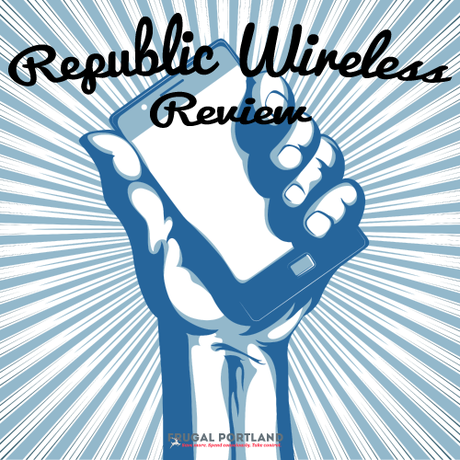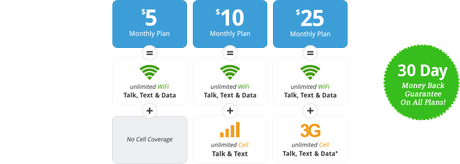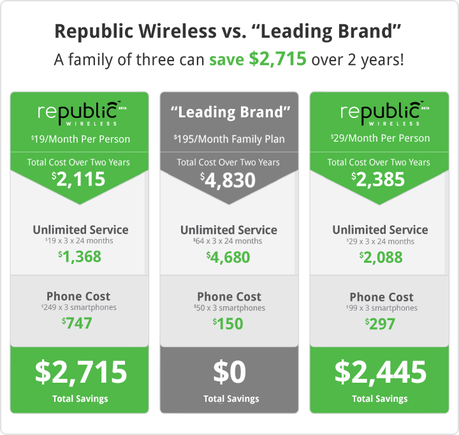
Notes from Kathleen: 1. We have an affiliate relationship with Republic, which means if you click our link, we get a small commission from them without it changing your price. 2. J. Money just wrote a review, because that’s the way the internet works, so if you’re interested in another opinion, go read his review, and if you like his better, click his link. We can still be friends.
Those are my only notes. Take it away, Brent!
Back in January of 2008, on my 28th birthday no less, I purchased an iPhone. This was the original, paradigm-shifting smartphone exclusive on AT&T. Even before new apps were available, this thing changed the game for anyone who had one. Check your email. Play your music. Surf the web. Oh, and make phone calls, too. Aside from Blackberries–which were really for corporate-on-the-go types– there was nothing within a zillion miles of the first iPhone in terms of groundbreaking functionality on the go.
I plunked down the $299-plus-fees, and started shelling out $89.99 a month for 900 anytime minutes, plus unlimited text and data. I rolled with iPhone and AT&T for five years, dutifully trading in my old iPhone for the latest version every two years: iPhone–>Iphone 3G–>iPhone 5 (with Siri!). And I shelled out over $100 a month for the privilege.
In the meantime, Google’s Android was busy taking over the world. The Android first release wasn’t anywhere near Apple’s amazing operating system, but bit by bit, Google matched, and then surpassed the iPhone in terms of capability. Didn’t take long for Android to start dominating the market, with every phone company and carrier providing multiple versions of phones.
For a long time, I was an apologetic Apple fanboy, touting the superiority of all things Apple (the iPhone, especially). But as time marched on, I started installing more and more Google apps onto my good old iPhone. Before you know it, I was checking email with Gmail, surfing with Chrome, sharing with Drive, navigating with Google Maps. I had, essentially, re-skinned my iPhone into an Android phone.
Here’s the dirty little secret about Android vs. iPhone: they both do the exact same things. Email? Check. Pandora? Yup. Text messaging? Duh. Phone calls? I hope so. There isn’t a thing worth a spit that you can do on Android that you can’t also do on an iPhone and vice versa.
Now, I have my preferences. If I’m being honest with you, I have to admit that, all things being equal, I’d choose iPhone over Android. But two things about that:
1. That’s just my personal taste
2. All things are not equal. Not by a long shot.
There are a ton of mobile options out there, but in all my time as an iPhone owner, I had never given much thought to leaving AT&T. I just paid and paid and paid for the same mediocre coverage. Six years ago, with a fledgling smartphone market, this made some sense. In 2014, it’s insane. There are so many alternative carriers that provide good nationwide coverage, that you are a complete chump if you’re paying more than, say, $50 a month for your phone service.
Enter Republic Wireless

They are the game-changing mobile company trying to upend traditional carriers through a clever strategy. You see, while Republic Wireless uses the same cellular network as Sprint, their phones prioritize WiFi for calls, texts, and surfing . And, in today’s hyperconnected world, WiFi is almost always available.
So, when you’re at home, calls you place, texts you receive, scores you look up, are routed over your home WiFi network. Also, at your office. And your favorite coffee shop. And the waiting room of your dentist. Anywhere with WiFi.
If you’re on a call, and go out of WiFi range, the phone automatically hands the call off to the cellular network, no fuss, no muss. Republic Wireless benefits because its users use far less cellular traffic when they’re calling and texting. You benefit because it’s way cheaper, and the paradigm of “cellular coverage” starts to break down.
The Price
Republic has four phone plans. The first (and fanciest) is the unlimited 4G talk/text/data plan for $40/month. Then you have the unlimited 3G talk/text/data for $25/month. For those without mobile data needs, there’s the unlimited talk/text, data WiFi only plan for $10/month. Finally, there’s what I like to call the “mobile landline,” which is WiFi-0nly for calls/text/data for $5/month.
I’m on the $25/month plan because I really don’t have the need for 4G data speed, the 3G network suits me just fine.
For an extra sweet feature, Republic allows you to easily change your plan through their app up to twice a month. Let’s say you’re headed out of the country. Just switch to the WiFi-only plan and you can send texts and make calls all day and night from anywhere in the world with WiFi at the $5/month rate. It is the cheapest international mobile plan in the world.
What’s more, no contracts.
The Service
The service is fine. I drop a call periodically when I’m out and about, but I was also able to stream World Cup soccer games on over cellular while I was in Two-Hours-From-Nothing, Nebraska, so make of that what you will. Frankly, service strength is irrelevant when you’re at home or work since you’ll likely be on WiFi all day long. For the curious: Republic uses Sprint as their primary cellular network, and Verizon to roam.
The Phones

As of today, you only have two options: the $149, 3G-only Moto G and the $299 4G Moto X. I can only speak to the X because the G wasn’t available when I joined up with Republic. I like the phone. As a recovering Apple fanboy, Android had a bit of a learning curve to it. The biggest weakness: Android is not the most stable operating system in the world. For the first few months, the phone would crash at least twice a week (sometimes in the middle of a call), and I’d have to perform a hard reboot. Once I updated my OS to KitKat, the crashes stopped. But even crashing wasn’t enough to put me off of the phone because I was paying less than a third of what Iw as paying while on AT&T.
The downside to Republic: you can’t bring your own phone to the network. You have to buy one of their two phones. But so what? The Moto X is a good phone. Fast, good camera, and it does everything I want it to do.
A Few of Caveats
While I strongly recommend Republic, there are a few things everyone should know before taking the plunge:
Customer Service
Their web-based customer service is not a strength of theirs. There are no phone numbers to call if something isn’t working properly. You have to go to their website and submit a ticket. Now, that includes an online community of fellow Republic users who are quite happy to answer any question you may have. Post your problem on the board, and you’ll probably receive an answer quickly.
MMS & Group Messaging
I’ve been having problems sending and receiving group text messages using Google Hangouts. One-on-one messages don’t seem to be a problem, and I’m currently searching for a messaging app that can handle group/MMS on this phone.
Slow Updates
Republic didn’t get the KitKat release for over six months after Google made it available. This is probably not the biggest problem for most people, but those who look for the latest and greatest will probably be frustrated.
But look, if you want the latest and greatest, then don’t bother with Republic. Go wait in line every fall with the other chumps for a new iPhone. I, on the other hand, am sick of wasting money on a piece of technology that has no functional difference from every other phone in the market.
Get Republic Wireless. It’s cheap. It works. You can have just about any app you want. You can make calls and send texts internationally for free. And you can do all of it for under $30 a month.

